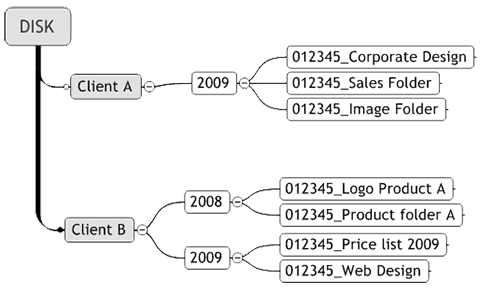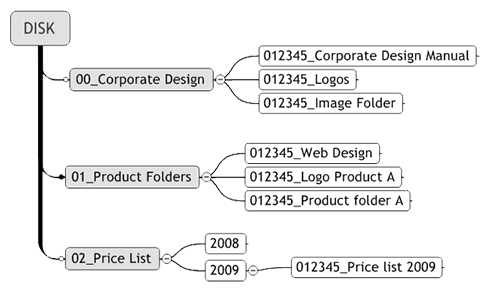Why should an art director be bothered with file structure, server setups and all this organization stuff? Isn't this the business of the IT-departments? Well, yes if you are in a big agency and you have an IT-department and even then only for the "physical" part. At the end of the day you and you team have to work with the files every day, not the IT-department, so it's time to get in charge. Here a few tips.
Art Directors are in charge
We agreed that the art director is the head of the graphic design team - so he is in charge to provide the tools for the team to work at it's best. If you look at the history of graphic design computers you will see that networking is one of the later evolutions. The high cost of this graphically powerful PCs (at the time mostly Macs) made the single user platforms. And later on the networking between Mac and PCs (on which most networking products relied) wasn't that good.
Since the introduction on OSX (which is a unix basically) and the more powerful networks this problems should arise anymore. It's still true that the amount of data used in graphic design are big, but this in no more an excuse for not using centralized servers (at least as repository). So if you are not working alone think about this four principles:
- Get a server = Hardware
- Make a nice structure = Software
- Work only the minimum amount locally = habit
- Make backups = safety
Get a server
I want to be specific here. Setup a separate computer as a server with server software (it doesn't matter if you use Windows, Mac OSX or Linux) and do not use a NAS (Network Attached Storage). And by setting up I PC I would really recommend to buy server hardware. You can start with a nice small Dell (you would be surprised about how low the prices are) and grow your server base as time goes by. Hardware made for servers is build to run 24/7 and are faster than any NAS you could find on the market.
To connect to the server use cables as wireless is still not fast enough and especially if you are more than just a bunch in your team you will feel the difference.
Last but not least - user access control. By setting up a server you can control who sees what. You can store all the important data in one place (where you can backup it) and still control that sensitive data is not seen by your co-workers.
Make a nice structure
Now how to build your structure can be more of an philosophical approach than you think. I had to do some serious structure layout for medium an bigger firms and I must admit that there is no single solution. I didn't find any help in books and I figured out two scenarios which work fairly well.
- Project oriented storage (for small to medium amount of assets)
- Object type storage (for huge amount of assets - may need a digital asset management)
I will focus here on the project oriented storage. It's fairly easy to manage as every project contains all the data needed. Much like the "collect all assets" in Undersign function. You may waste some disk space, but you can be sure that you can reprint a document even after a couple of years. It prevents you from looking for a specific file which you maybe moved to another folder by accident or because you where "cleaning" your file structure. It also prevents you from overwriting logos and images with newer versions. And don't forget the time saving if you have to collect the data for your client.

The first example of a structure shows all elements I mentioned plus a few more. This is suited for agencies with multiple clients. Notice the client is at top level followed by the year. This will help you when you search and navigate through the file structure. I also inserted the tracking number (you remember to always track your jobs) leading the project name. This is also a big help when you have to search for the job and when you make backups and archives.

The second example shows an inhouse graphic department. Here you have only one client and your work will focus more on recurring project types. So the top level is based on this project types. A classification by year is here not always useful, as some projects will last longer or are valid for a longer period of time. The taxonomy (the difficult word for a structured and controlled vocabulary) for such an inhouse agency file tree will discussed next week when we talk about DAM (digital asset management).
Work only a minimal amount locally
Now that you have a server you should work on your local harddisk only when you are handling huge files. To be sure to not lose any data I have even installed on the working machines RAID Systems. So if even one disk crashes I don't lose the work I've done. Synchronizing local folders to server folders can be a solution, but only if you work alone on a project. If more than one person handles files in folder and you have to synchronize 2 local machines to a server then it gets troublesome.
Make backups
Finding the right backup strategy is also quite difficult. But it is really important that you have a "strategy" - I mean by strategy that you should have a routine, daily, weekly, monthly and archiving. The more you can automate the better, but don't rely solely on automatic backups. I have a mixed strategy. Daily differential backups on tape. Weekly complete backups on two different external harddrives and weekly differential online backup. The external harddrives are stored one offsite (in a bank) and one locally for restoring.
Make the single folders small enough to make them stay on a DVD for archiving. Archiving of project you know you will not touch anymore keeps your server slender. But I don't archive only on DVD but also on other harddrives as well.
Looks like a lot of trouble for keeping your data safe. Well, for me there is nothing more annoying than redoing a job because I lost the data.












Comments (2)
I agree with you on just about any server hardware being much faster than any NAS. However for a SoHO sized business a NAS can be a good interim move before a company can justify a 'proper' server purchase. However, if you do go down the NAS route make sure that you have a level of data redundancy. Before getting servers and a RAID array at my own company, I had had a 5-drive NAS unit configured to RAID 6 which gave sterling service.
I had the oportunity to buy my servers for my home office when Dell introduced their new starter rack range. For a limited time they where sold in Italy for 500 Euro - a bargain. And if you have space and don't want to use rack servers you can start for the same price as a NAS. The one reason to start with a NAS is that you have less administration to do and you get used to use a server. So it might as you said be best as a middle step.